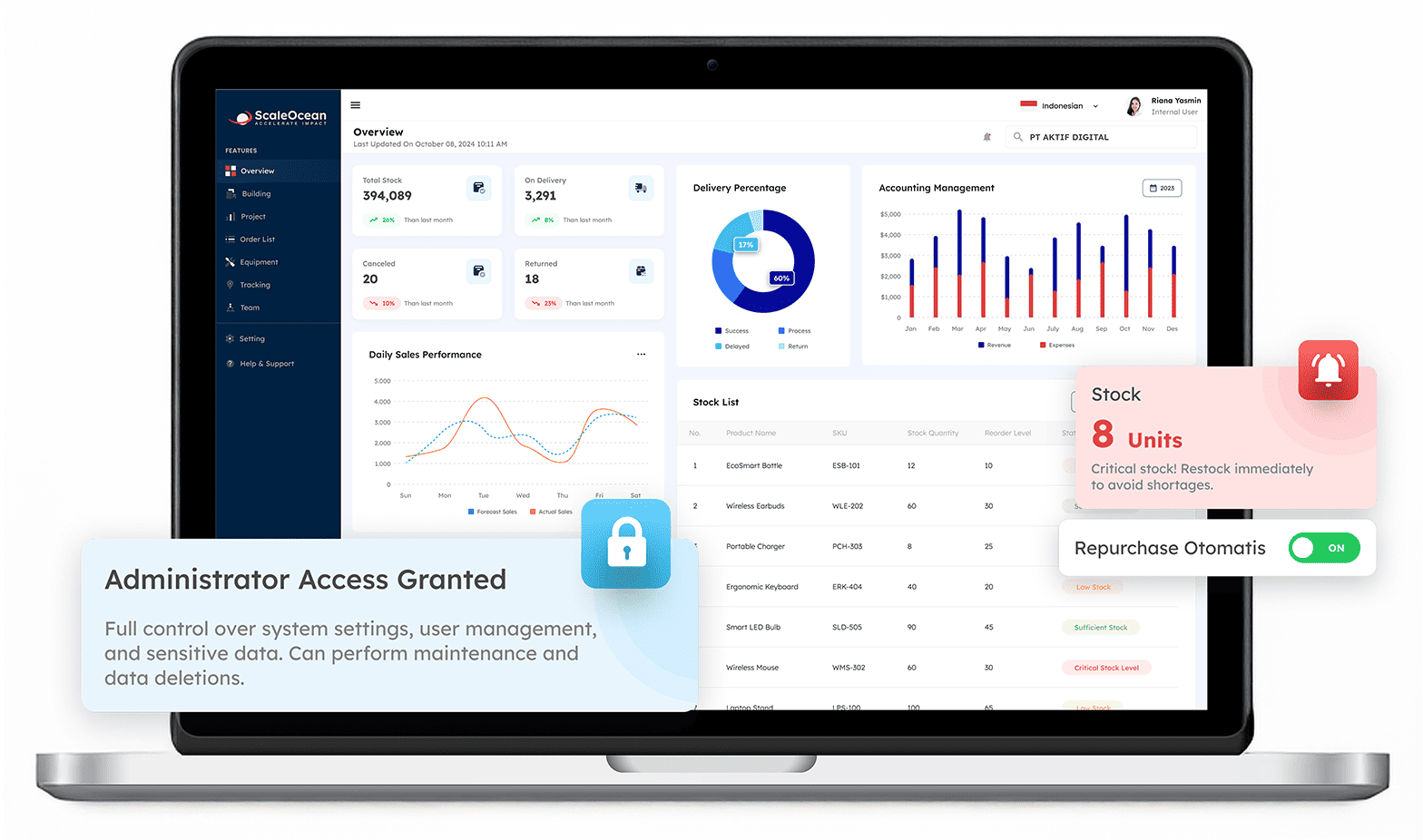In today’s fast-paced corporate environment, business analytics is more crucial than ever. Across industries, companies are relying on data-driven insights to guide strategies, improve performance, and enhance decision-making. This trend is particularly strong in Singapore, where businesses are embracing advanced technologies like ERP systems to stay ahead of the competition. According to Imarc Group, the Singapore ERP software market is projected to grow at a CAGR of 11.02% from 2025 to 2033, driven by the adoption of cloud-based solutions and a greater focus on data analytics and real-time reporting.
With ERP systems enabling seamless data integration, businesses can transform raw data into actionable insights that fuel growth and innovation. This article explores the significance of business analytics in modern business operations. We’ll cover the core principles of business analytics, the various tools available, and the benefits they offer in improving decision-making and performance. Additionally, we’ll address the challenges companies face when implementing analytics solutions and how leveraging these tools can ensure long-term success.
- Business analytics is the process of extracting valuable insights from data through statistical analysis and machine learning to guide business decisions.
- Business analytics consists of four key components that help organizations turn raw data into actionable insights for better decision-making and improved performance.
- Business analytics offers numerous benefits that help businesses optimize operations, improve performance, and drive growth through data-driven decisions.
- ScaleOcean provides a comprehensive business analytics solution that integrates seamlessly with its ERP system to streamline analytics processes.

1. What is Business Analytics?
Business analytics is the activity of extracting valuable insights from data through statistical analysis and machine learning to drive business choices. It entails converting raw data into usable information, which enables enterprises to make informed decisions that improve their performance. Business analytics helps identify opportunities and inefficiencies, resulting in better business outcomes.
In today’s fast-paced and competitive climate, using business analytics is critical to keeping ahead. Companies that properly use analytics can improve decision-making, operational efficiency, and respond to market changes faster. Finally, business analytics enables firms to not only evaluate previous performance but also forecast future patterns, enabling proactive and data-driven plans for long-term growth.
2. The Core Components of Business Analytics
Business analytics consists of four key components that help organizations turn raw data into actionable insights, enabling better decisions and improved performance. Each component offers a unique perspective on data, providing a comprehensive view of operations. Businesses interested in adopting these solutions can also explore business grants to help cover implementation costs. Let’s take a closer look at these fundamental components.
a. Descriptive Analytics
Descriptive analytics focuses on evaluating historical data to determine what happened. Businesses can get a clear picture of their performance by summarizing historical data in reports, dashboards, and visualizations. This includes assessing data such as sales trends, customer behavior, and operational efficiency to assist firms assess their performance and uncover patterns that will drive future decisions.
b. Diagnostic Analytics
Diagnostic analytics dives deeper into determining the underlying reasons of specific business occurrences. It investigates the causes that led to certain outcomes, assisting firms in identifying areas of concern or chances for change. Root cause analysis is a common technique used to identify underlying difficulties, such as supply chain inefficiencies or gaps in customer satisfaction, allowing firms to successfully address the main problems.
c. Predictive Analytics
Predictive analytics forecasts future occurrences or trends by combining historical data with advanced algorithms like machine learning. Businesses can forecast outcomes such as sales volumes, market demand, and customer behavior by recognizing patterns and trends in historical data. This forward-thinking strategy enables businesses to plan ahead, allocate resources effectively, and make proactive decisions to reduce risks and seize opportunities, which is an essential component of Enterprise Risk Management (ERM).
d. Prescriptive Analytics
Prescriptive analytics goes beyond forecasting future outcomes and suggests specific steps to improve corporate performance. It gives enterprises actionable insights by recommending the optimal course of action based on data-driven scenarios. Businesses that optimize decisions can improve processes, cut costs, and achieve strategic goals more effectively. This form of analytics assists firms in refining their plans and maximizing success.
3. Types of Business Analytics Tools
firm analytics tools exist in a variety of forms, each serving a different purpose based on the complexity of the study and the size of the firm. These tools enable businesses to effectively use data, streamline operations, and make educated decisions. The following are the main categories of business analytics tools:
a. Traditional Analytics Tools
Traditional analytics tools, including spreadsheets, databases, and basic business intelligence (BI) systems, have long served as the foundation for data analysis. These tools enable firms to collect, organize, and analyze data, resulting in reports and visualizations that summarize previous performance.
However, they are frequently limited in their ability to give real-time insights or manage massive, complex databases. Traditional technologies, while still effective for basic reporting and analysis, may struggle to fulfill the needs of today’s data-driven enterprises.
b. Advanced Analytics Tools
Advanced analytics technologies, including machine learning algorithms and AI-powered platforms, provide deeper insights by analyzing vast amounts of data in real time. These systems can uncover complex patterns, predict trends, and offer actionable recommendations. ERP systems enhance this process by integrating data across departments using application integration tools, allowing businesses to turn insights into strategic actions swiftly.
With the power of advanced analytics and ERP, companies can move beyond basic analysis, making faster, more accurate decisions. These technologies are essential for businesses aiming to stay ahead of the competition and quickly adapt to emerging trends.
c. Cloud-Based Analytics Tools
Cloud-based analytics platforms are scalable, flexible, and cost-effective, allowing firms to examine data without requiring costly infrastructure. When combined with ERP systems, these platforms enable real-time data analysis, effective collaboration, and data-driven optimization across departments. Choosing the best ERP software Singapore improves these capabilities, allowing businesses to get the most out of analytics tools.
For businesses looking for agility in managing fluctuating data demands or reducing infrastructure costs, cloud-based analytics, combined with ERP, provides a streamlined solution. With ERP systems facilitating data flow across business functions, companies can unlock actionable insights, enhance decision-making, and drive growth.
Also Read: How to Prevent ERP System Failures for Businesses
4. Benefits of Business Analytics for Businesses
Business analytics provides numerous advantages that assist firms optimize their operations, increase performance, and drive growth. Businesses may use data to make more informed decisions, cut expenses, improve efficiency, and better understand their customers. Here’s how business analytics can help your corporation.
a. Improved Decision Making
Business analytics improves decision-making by offering reliable, data-driven insights. Companies can use real-time data to make informed decisions that have a direct influence on performance and growth. By analyzing performance metrics, business executives can quickly modify strategy depending on new information, ensuring they remain competitive in a rapidly changing market.
b. Cost Reduction
Organizations can use business analytics to uncover inefficiencies and potential savings opportunities. Predictive and prescriptive analytics provide opportunities for streamlining operations, reducing waste, and optimizing resources. This leads to cost reductions, allowing firms to better manage resources and enhance their bottom line.
c. Operational Efficiency
Business analytics enhances operational efficiency by allowing firms to optimize procedures and minimize bottlenecks. Organizations that streamline processes can respond faster to market needs and increase overall efficiency, resulting in smoother operations and improved performance across divisions.
d. Customer Insights
Business analytics gives significant insights into client preferences and habits, enabling organizations to better meet their demands. Companies that analyze data can personalize their products, services, and marketing efforts, resulting in increased consumer satisfaction and loyalty. This allows firms to retain consumers and boost lifetime value.
5. Who Uses Business Analytics?

Business analytics is crucial in many areas, including retail, healthcare, manufacturing, and financial services. These industries rely on data-driven insights to manage operations, improve consumer experiences, and remain competitive in the market. Corporate analytics may help firms identify patterns, trends, and areas for improvement that are critical for corporate success and innovation.
Executives, analysts, operations managers, marketing teams, and finance specialists all play important roles in firms that benefit from business analytics. These professionals use business analytics to get important insights into performance, customer behavior, and operational trends. By exploiting these insights, businesses may make more educated decisions that result in better outcomes, such as cost savings, increased efficiency, and greater strategic direction.
6. The Role of Data in Business Analytics
Data is the foundation of business analytics, and its quality has a direct impact on the insights generated. To ensure that analytics yield useful insights, firms must first collect accurate, full, and structured data. This procedure entails organizing raw data, removing discrepancies, and filling in gaps to establish a solid foundation for analysis. According to the Government Executive, for 30 years, the federal government has used a smart data approach to ensure data integrity and operational efficiency in managing government contracts and grants.
Data governance is also critical, as it ensures that data is managed safely and in accordance with industry laws. Proper data governance protects privacy, minimizes risks, and ensures data integrity. Without proper governance, the usefulness of corporate analytics suffers, since untrustworthy or unsecure data can lead to inaccurate conclusions and compromised decision-making.

7. Challenges in Implementing Business Analytics
Implementing business analytics presents various hurdles that firms must overcome. One of the key challenges is data quality. Incomplete, inaccurate, or inconsistent data can result in erroneous conclusions and poor decision-making. High-quality data necessitates thorough cleaning and validation processes, which can be time-consuming and resource-intensive.
Another issue is the shortage of competent workers. Data scientists, analysts, and IT professionals are critical for understanding complex data and drawing effective conclusions. Many firms experience a talent scarcity, making it difficult to properly utilize analytical tools. Furthermore, the cost and complexity of integrating sophisticated analytics systems might be prohibitive, particularly for smaller firms with limited resources.
Also Read: ERP Maintenance: Steps Practice and Key Benefits
8. Why Business Analytics is Essential for the Future
As the business landscape evolves rapidly, business analytics is becoming crucial for staying competitive. Technologies like artificial intelligence (AI), machine learning, and automation are transforming how companies process and analyze data, providing deeper insights and enabling more informed decisions. ERP systems support this by integrating business processes and offering real-time access to data, helping businesses align their operations and enhance enterprise management.
Early adoption of business analytics allows companies to respond quickly to market changes, optimize performance, and make better decisions. With ERP systems consolidating data across departments, businesses can proactively identify trends, solve problems, and seize opportunities, ensuring long-term growth and maintaining a competitive edge.
9. ScaleOcean: A Comprehensive ERP and Business Analytics Solution

ScaleOcean offers a comprehensive business analytics solution that streamlines analytics processes within an integrated ERP system. With real-time data analytics, user-friendly dashboards, and seamless integration with other business systems, businesses can quickly access critical insights. The platform’s simplicity ensures easy data retrieval, helping organizations improve operations and performance. By combining business analytics with ERP functionalities, ScaleOcean optimizes both data analysis and overall workflow management.
Companies may use ScaleOcean’s strong business analytics solutions to make more educated, data-driven decisions that improve performance and drive growth. ScaleOcean’s ability to monitor important indicators, predict trends, and identify areas for improvement enables enterprises to move quickly and efficiently. Take advantage of ScaleOcean’s free demo to see how it may improve your decision-making processes. Additionally, with the CTC grant available, businesses can further lower the cost of deploying this solution. Here is a list of ScaleOcean’s primary USPs:
- Unlimited User Access for Scalable Analytics, ScaleOcean offers 100% unlimited user access without any additional costs, allowing businesses to scale without worrying about added expenses.
- Comprehensive, All-in-One Solution for Tailored Analytics, With over 200 specialized modules and 1,000+ feature options, ScaleOcean provides a comprehensive and customizable solution tailored to the specific needs of your business.
- Industry Best Practices for Seamless Data Insights, Designed to address the challenges of various industries—from operations management to automation—ScaleOcean leverages best industry practices to deliver a seamless analytics experience.
- Customizable Analytics to Fit Your Business Needs, ScaleOcean allows businesses to tailor the solution to their specific workflows. With personalized dashboard displays and advanced smart configurations for each division, companies can align the platform with their unique business requirements, ensuring relevant and actionable insights are delivered to every team.
10. Conclusion
Integrating business analytics into your operations is no longer a choice; it is necessary for long-term success and sustaining a competitive advantage. Businesses can use data-driven insights to improve performance, make educated decisions, and identify opportunities that would otherwise go undiscovered. Understanding patterns, forecasting future results, and streamlining procedures are critical for success in today’s data-driven environment.
Exploring strong analytics solutions such as ScaleOcean is critical for completely unlocking your data’s potential and improving business outcomes. ScaleOcean, with its comprehensive capabilities like real-time data analytics and configurable solutions, may assist your organization in realizing the full potential of its data. Don’t miss out on ScaleOcean’s free demo, which will show you how its solutions may alter your decision-making process and promote corporate growth.
FAQ:
1. What are the 4 types of business analytics?
The four types of business analytics are descriptive, diagnostic, predictive, and prescriptive analytics. Descriptive analytics examines past data to understand what happened. Diagnostic analytics explores the reasons behind specific events or outcomes. Predictive analytics uses historical data to predict future trends, while prescriptive analytics suggests actions to optimize future results.
2. Is MBA or business analytics better?
The decision between an MBA and business analytics depends on individual career goals. An MBA provides comprehensive management knowledge, ideal for leadership roles, while business analytics focuses on data-driven decision-making and analytical tools, making it a better fit for roles centered around data analysis and business optimization.
3. Is business analytics a good career?
Business analytics is a promising career, with growing demand for professionals skilled in data analysis. Companies are increasingly turning to data to drive decisions, creating numerous opportunities for those specializing in business analytics, such as data analysts and data scientists, across industries.
4. What do business analysts do?
Business analysts gather and analyze data to identify business needs and improve processes. They provide insights and recommendations that help organizations make data-driven decisions and optimize operations, ultimately supporting the company’s overall goals and strategy.







 PTE LTD..png)
.png)

.png)








.png)
.png)
















